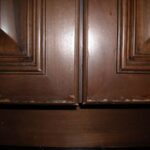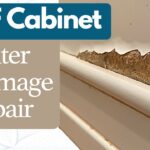Are your kitchen cabinets looking less than perfect due to peeling wood stain? You know how frustrating it can be to see your once beautiful cabinets losing their charm.
But don’t worry, you’re not alone, and there’s a solution. Imagine walking into your kitchen and feeling proud of its flawless look again. It’s easier than you think to restore your cabinets to their former glory. In this guide, you’ll discover simple steps to repair peeling stains on wood-stained kitchen cabinets, saving you time and money.
You’ll feel empowered with the knowledge to tackle this issue head-on, bringing back the elegance and warmth to your kitchen space. So, let’s dive in and transform your kitchen into the stunning heart of your home. Keep reading to unlock the secrets to a quick and effective cabinet makeover.
Identifying Peeling Stain Issues
Kitchen cabinets are the heart of your culinary space, where functionality meets style. However, over time, the stain on your wood cabinets may start to peel, compromising their aesthetic appeal. Understanding the reasons behind this peeling and recognizing the early signs can save you from more extensive repairs later. Let’s dive into identifying these peeling stain issues.
Common Causes Of Peeling
Peeling stain is not just an eyesore; it is a signal that something is amiss. Moisture is a major culprit, often entering the wood from small leaks or spills that aren’t promptly cleaned up. Inadequate preparation before staining, such as not sanding or cleaning properly, can also lead to poor adhesion, causing the stain to lift.
Moreover, using incompatible or low-quality stains can exacerbate peeling. Have you recently switched to a different cleaning product? Harsh chemicals can strip the protective layer of your cabinets. Reflect on these factors when diagnosing the issue.
Signs Of Damage
Spotting peeling stain early is crucial to managing it effectively. Look for small bubbles or cracks in the finish, as these are often the first signs of distress. Discoloration or patches where the wood looks lighter might indicate that the stain is beginning to separate from the surface.
Run your fingers gently across the cabinet surface. Do you feel any rough or raised areas? These could be sections where the stain is starting to peel away. Regularly inspecting your cabinets can help you catch these issues before they escalate.
Have you noticed any of these signs on your kitchen cabinets? Taking action now can preserve their beauty and functionality for years to come.
Preparing For Repair
Fixing peeling stain on wood kitchen cabinets starts by cleaning the surface. Sand the affected areas gently. Apply a matching stain evenly.
Repairing peeling stain on your kitchen cabinets can seem daunting, but with proper preparation, you can restore them to their former glory. It’s a straightforward process that requires some basic tools and a bit of patience. Before you dive into the actual repair work, understanding how to prepare is crucial. Preparation ensures that you have everything in place, making the repair process smoother and more efficient.Tools And Materials Needed
To tackle the peeling stain effectively, gather all necessary tools and materials first. You will need sandpaper, a putty knife, wood stain, a brush, and a soft cloth. Sandpaper helps smooth out the peeling areas, while the putty knife assists in removing loose stain. Choose a wood stain that matches your existing cabinets for a seamless look. Having a brush and cloth on hand allows you to apply and wipe the stain evenly. Pro tip: Keep a small vacuum or a dustpan nearby to clean up the sanding debris, saving you time later.Safety Precautions
Safety should be your top priority when working on home repairs. Start by ensuring you have proper ventilation in the area. Open windows or use fans to circulate air and minimize inhaling fumes from the wood stain. Wear gloves to protect your skin from chemicals in the stain and sanding dust. If you’re sensitive to strong odors, consider wearing a mask to safeguard your respiratory health. A personal insight: I once neglected to wear gloves while staining and ended up with stained hands for days. It’s a simple yet effective step that makes a big difference. Preparing for repair might seem like extra work, but it sets the stage for a successful project. Have you ever started a task only to realize you were missing something essential? Taking the time to prepare not only avoids such pitfalls but also makes the process enjoyable and rewarding.Removing Old Stain
Removing the old stain from wood cabinets is crucial. It ensures a smooth and appealing finish. The process involves careful sanding and using chemical strippers. Both methods are effective in their unique ways. Understanding these techniques can make the task easier. Let’s dive into the details of each method.
Sanding Techniques
Sanding is a common method for removing old stain. It involves using sandpaper to strip the surface. Start with coarse-grit sandpaper. This removes the bulk of the old stain. Gradually move to finer grits for a smooth finish. Always sand in the direction of the wood grain. This prevents scratches and maintains the wood’s natural look. A power sander can speed up the process. But be cautious not to sand too deeply. Sanding too much can damage the wood.
Chemical Strippers
Chemical strippers dissolve the old stain. They are effective for intricate designs where sanding is tough. Apply the stripper with a brush, covering the entire surface. Let it sit for the recommended time. This allows the chemicals to break down the stain. Use a plastic scraper to remove the loosened stain. Always wear protective gloves and work in a well-ventilated area. Chemical strippers can be harsh. Ensure you follow all safety instructions carefully. Rinse the surface with water to remove any residue. Dry the wood completely before applying a new finish.
Repairing Damaged Areas
Peeling stain on wood kitchen cabinets can be fixed by sanding the area. Apply a matching stain and finish. This process restores the cabinet’s look while protecting the wood.
Repairing damaged areas on your wood-stained kitchen cabinets is a crucial step to restore their beauty and functionality. When stains start to peel, it can leave unsightly patches that detract from the kitchen’s overall charm. Tackling these damaged spots not only improves aesthetics but also prolongs the life of your cabinets.Filling Cracks And Holes
Begin by identifying all cracks and holes on the cabinet surface. Use a wood filler that matches the color of your cabinets to ensure a seamless look. Apply the filler with a putty knife, pressing it into the damaged areas. Allow the filler to dry completely, which usually takes a few hours. After drying, check the surface to see if additional filling is necessary. This step ensures a smooth base for the rest of your repair work.Smoothing Surface
Once the filler is dry, it’s time to smooth the surface. Use fine-grit sandpaper to gently sand the filled areas. This action removes excess filler and creates an even texture. Regularly wipe away dust with a damp cloth to see your progress. If the surface feels uneven, continue sanding until it’s perfectly smooth. Remember, a smooth base is essential for a flawless finish when you re-stain the cabinets. Have you ever thought about how much a smooth surface impacts the final look of stained wood? It’s often the difference between a professional appearance and a DIY project gone wrong. Paying attention to these details makes a significant difference in your kitchen’s appeal. By addressing these damaged areas with care and precision, you’re not just fixing a problem—you’re enhancing the heart of your home. What other home improvement projects have you tackled that made a noticeable difference? Share your stories and insights in the comments below!Applying New Stain
Repairing peeling stain on wood stained kitchen cabinets involves applying a new stain. This step refreshes and protects the cabinets. Before starting, ensure the surface is clean and sanded. Proper preparation helps the new stain adhere well.
Choosing The Right Stain
Select a stain that matches your existing cabinet color. Oil-based stains offer a rich finish and are durable. Water-based stains dry quickly and have less odor. Consider the desired finish. Do you want a glossy or matte look? Test a small area first to ensure satisfaction with the color.
Application Tips
Use a clean brush or cloth for application. Apply the stain in the direction of the wood grain. Avoid applying too much at once. It can lead to uneven drying. Wipe off excess stain with a clean cloth. Let the stain dry completely before adding a second coat. Follow the manufacturer’s instructions for drying times. Ensure good ventilation in the room for quicker drying. Proper application ensures a smooth, lasting finish.
Credit: www.washingtonpost.com
Finishing Touches
Peeling stain on wood kitchen cabinets can be fixed with simple techniques. Clean the surface and lightly sand the peeling areas. Apply a matching wood stain to restore the cabinet’s appearance and protect the wood.
When you’ve invested time and effort into repairing peeling stain on your wood-stained kitchen cabinets, the finishing touches are crucial. They ensure that your hard work lasts and your cabinets look polished and professional. These final steps are not just about aesthetics; they also protect and preserve your cabinets for years to come.Sealing For Protection
Sealing your cabinets is essential for long-lasting protection. A good sealer acts as a shield against moisture, stains, and everyday wear and tear. Choose a sealer that complements the stain you’ve used, whether it’s oil-based or water-based. Apply the sealer in thin, even coats. Use a high-quality brush or a foam applicator to avoid streaks and bubbles. Allow ample drying time between coats; this patience pays off with a smooth and durable finish. Have you ever noticed how much better a job looks when it’s protected from the elements? That’s the power of a good seal.Ensuring Uniform Finish
Achieving a uniform finish is the cherry on top of your cabinet repair. This step ensures that all parts of the cabinet match seamlessly, avoiding any patchy or uneven areas. Inspect your cabinets under good lighting to spot any inconsistencies. Lightly sand any uneven spots before applying another coat of stain or sealer. This attention to detail makes a big difference in the final appearance. Consider the last time you saw a beautiful piece of furniture. Did you notice how flawless and consistent its finish was? This is the effect you’re aiming for with your kitchen cabinets. The finishing touches on your cabinets are about more than just looks. They protect your investment and enhance the beauty of your kitchen. So, take the time to seal and ensure a uniform finish. You’ll thank yourself every time you walk into your kitchen.Maintaining Cabinet Finish
Maintaining the finish on your kitchen cabinets is important. It keeps them looking new and protects the wood. A well-maintained finish prevents peeling and damage. Regular care can extend the life of the cabinets. It also enhances the aesthetic appeal of your kitchen.
Understanding how to maintain your cabinet finish is crucial. Simple steps can make a big difference.
Regular Cleaning
Clean your cabinets regularly. Use a soft cloth to remove dust and grime. Avoid harsh chemicals that damage the finish. Mild soap and water work best. Dry the cabinets completely after cleaning. This prevents water spots and damage.
Check for any sticky spots or spills immediately. Wipe them off to avoid staining.
Preventive Measures
Preventive measures help maintain the cabinet’s finish. Keep cabinets away from direct sunlight. Sunlight can fade and damage the finish. Use curtains or blinds to shield them.
Always use a coaster or placemat under hot items. Heat can cause peeling and discoloration. Maintain a stable humidity level in your kitchen. High humidity warps wood and damages the finish.
Inspect the cabinets regularly for any signs of wear. Address issues before they worsen. This ensures your cabinets stay in top condition for years.

Credit: www.washingtonpost.com

Credit: www.reddit.com
Frequently Asked Questions
How Can I Fix Peeling Stain On Cabinets?
Start by sanding the peeling area. Apply matching stain. Seal with a protective finish for durability.
What Causes Stain Peeling On Wood Cabinets?
Moisture and heat can cause stain to peel. Poor initial application might also lead to peeling issues.
Can I Prevent Stain From Peeling Again?
Ensure proper ventilation and humidity control. Regularly clean and maintain cabinets to prevent future peeling.
Do I Need To Remove Old Stain Completely?
Only remove loose or damaged areas. Sand lightly to blend with surrounding wood before applying new stain.
What Tools Are Needed For Repair?
You’ll need sandpaper, a brush, matching stain, and a sealant. A clean cloth is helpful for applying stain evenly.
Conclusion
Fixing peeling stain on kitchen cabinets is simple and rewarding. Follow each step carefully for the best results. Sanding and cleaning make the surface smooth and fresh. Applying new stain restores the cabinet’s beauty and protects the wood. Patience is key for even, lasting results.
Regular maintenance keeps your cabinets looking great for years. Your kitchen will feel refreshed and inviting with well-cared-for cabinets. Keep practicing these steps for improved DIY skills. Save time and money with these easy repairs. Enjoy your beautiful kitchen with restored cabinets.
Happy fixing!





